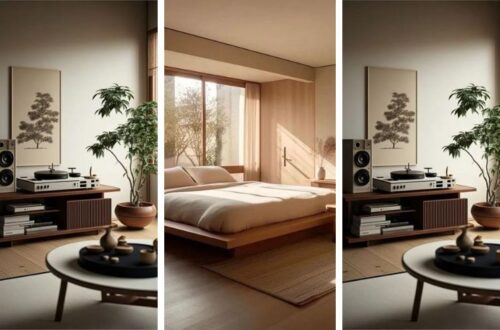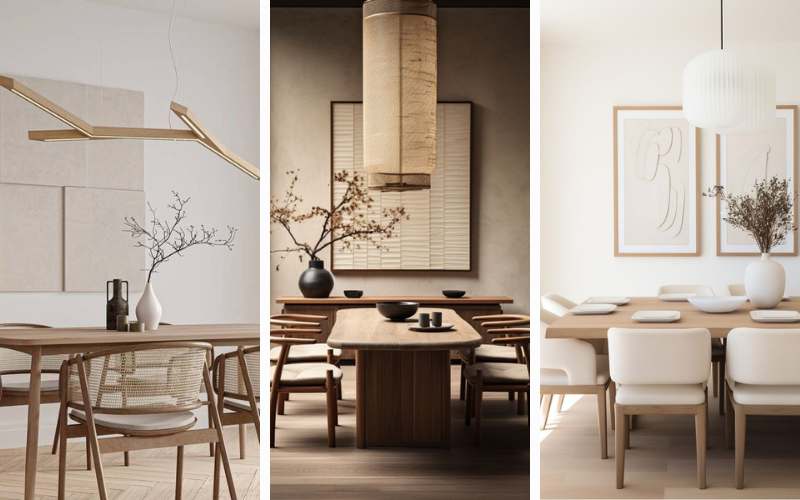
Japandi Dining Room
Share this
Japandi dining room decor ideas and tips!
As I stood in my cluttered dining room, overwhelmed by the mismatched decor and unnecessary knick-knacks, I knew it was time for a change.
That’s when I discovered Japandi style – a beautiful fusion of Japanese minimalism and Scandinavian functionality.
This revelation not only transformed my dining space but also my entire approach to home design.
In this blog post, I’ll share my journey into the world of Japandi dining rooms, exploring how this style’s emphasis on minimalism and decluttering can create a serene, organized, and visually stunning space.
Whether you’re a longtime fan of clean lines and neutral tones or just beginning to explore the Japandi aesthetic, you’ll find inspiration and practical tips to bring this harmonious style into your own home.
Let’s embrace the less-is-more philosophy and discover how a Japandi dining room can elevate your daily life.
Japandi Dining Room
Embrace the serene fusion of Japanese minimalism and Scandinavian functionality in your Japandi-inspired dining space. Here’s how to create a harmonious atmosphere that’s both inviting and stylish:
Embrace Open Spaces and Natural Light
- Maximize natural light with sheer curtains or bare windows
- Keep the space uncluttered to promote a sense of calm
- Use light-colored walls to enhance brightness
Smart Solutions for Every Space Size
Small Dining Areas
- Opt for compact, multi-functional furniture
- Consider a drop-leaf table for flexibility
- Utilize bench seating to maximize space
Larger Dining Rooms
- Choose a substantial table as a focal point
- Add comfortable seating for leisurely gatherings
- Incorporate a statement pendant light for ambiance
Open-Concept Harmony
For spaces where dining, kitchen, and living areas flow together:
- Maintain a cohesive color palette throughout
- Use consistent natural materials (wood, stone, bamboo)
- Create visual transitions with sliding doors or decorative screens
Japandi-Inspired Decor Tips
- Display handcrafted ceramics or wooden bowls
- Add texture with linen tablecloths or placemats
- Incorporate plants for a touch of nature
Remember, the key is to create a space that feels both functional and inviting, regardless of its size.
Related: Living and dining room combo
Don’t forget to Pin!


What Is Japandi Style
Imagine a design style that marries the serene simplicity of Japanese aesthetics with the cozy functionality of Scandinavian interiors.
Welcome to Japandi, a harmonious blend that’s captivating homeowners and interior designers alike.
At its core, Japandi draws inspiration from two profound philosophies:
- Wabi-sabi: This ancient Japanese concept celebrates the beauty in imperfection, simplicity, and the natural cycle of growth and decay.
- Hygge: The Scandinavian practice of creating warm atmospheres that promote wellbeing and contentment.
Key Elements of Japandi Design
- Clean Lines: Smooth, modern silhouettes that exude elegance without fuss.
- Neutral Color Palette: Earthy tones that create a calm, inviting atmosphere.
- Natural Materials: Wood, bamboo, and stone take center stage, bringing the outdoors in.
- Textural Contrasts: Rough linens alongside sleek ceramics for visual and tactile interest.
- Functional Beauty: Every piece serves a purpose while contributing to the overall aesthetic.
Why Japandi Endures
Unlike fleeting trends, Japandi’s appeal lies in its timeless principles:
- Mindful Living: Encourages a clutter-free, intentional approach to home design.
- Sustainable Focus: Emphasizes quality over quantity, promoting longevity in furnishings.
- Versatility: Adapts beautifully to various architectural styles and personal preferences.
Bringing Japandi Home: Top Tips
- Declutter with Purpose: Embrace minimalism, keeping only items that spark joy or serve a function.
- Invest in Quality Pieces: Choose well-crafted furniture that will stand the test of time.
- Balance Light and Dark: Pair light woods with darker accents for depth and visual interest.
- Incorporate Nature: Use plants, natural fibers, and organic shapes to soften the space.
- Play with Textures: Layer different materials to add warmth and dimension to your rooms.
Related: Minimalist dining room
How To Decorate Japandi Style Dining Rooms
Furniture
When selecting Japandi style furniture, focus on pieces that embody clean lines and natural materials. The ideal Japandi dining table often showcases:
- Light wood tones
- Slim profiles
- A beautifully time-worn appearance
A wooden table with minimal embellishments exudes Japandi charm, striking the perfect balance between simplicity, minimalism, and the warmth of Wabi-Sabi aesthetics.
Key considerations for Japandi dining furniture:
- Versatility: Choose pieces that cater to various dining needs.
- Seating: Opt for wooden or upholstered chairs with sleek, unadorned frames.
- Comfort: Prioritize comfort without compromising on style.
- Flexibility: Consider benches or stools for smaller spaces or multifunctional seating.
Incorporate rugs
Anchor the room with a natural fiber rug in soft, subdued hues—think warm beige or cool slate.
Choose simple patterns or solid colors to maintain a serene atmosphere that complements your overall design.
Lighting
Illuminate your gatherings with pendant lights that blend form and function.
Look for sleek, understated designs crafted from organic materials like woven bamboo or delicate paper.
These fixtures not only provide gentle lighting but also infuse the area with a cozy, inviting ambiance.
Elevate both style and practicality with open shelving units.
Whether crafted from rich, warm wood or sleek, industrial metal, these versatile pieces offer the perfect canvas to showcase your personality.
Adorn them with carefully chosen objects—perhaps a collection of handmade ceramics, vintage cookbooks, or lush potted plants—to add character and charm to your dining space.
Decorative elements
Adorn your walls with minimalist paintings, delicate Japanese calligraphy, or nature-inspired prints that evoke a sense of tranquility and connection to the natural world.
These pieces not only add character but also create a calm, meditative atmosphere.
Introduce texture and visual interest with strategically placed ceramic vases, sleek stone sculptures, or handcrafted pottery on shelves and tables.
When setting the table, opt for earth-toned ceramics, smooth wooden utensils, and crisp linen placemats to maintain the simplicity characteristic of Japandi style.
A vase of fresh flowers or a potted plant can serve as a natural, understated centerpiece, bringing a touch of life to your dining space.
Textures + materials
The essence of Japandi design lies in its thoughtful use of textures and materials.
Incorporate natural elements like solid wood, smooth stone, and textiles with subtle textures to add depth and warmth to your dining area.
These tactile elements complement the visual aesthetics, creating a harmonious and inviting atmosphere that engages all the senses.
Warm color palette
Japandi aesthetics embrace a subdued color scheme, but don’t mistake this for coldness.
The style artfully weaves in earthy hues like mellow beige, understated taupe, and soft greige.
These nature-inspired tones breathe life into spaces, creating an ambiance of serenity and equilibrium.
The result? Rooms that feel both sophisticated and invitingly cozy, striking the perfect balance between minimalism and warmth.
Fluted wood details
This technique, which involves carving precise vertical grooves into pale wood, transforms a simple surface into a captivating visual symphony.
The intricate fluted details serve as a counterpoint to the room’s minimalist aesthetic, infusing the space with depth and character.
More than mere decoration, these patterns showcase the remarkable skill and artistic vision of the craftsman, elevating the table from a functional piece to a true work of art.
Japandi Dining Room Ideas
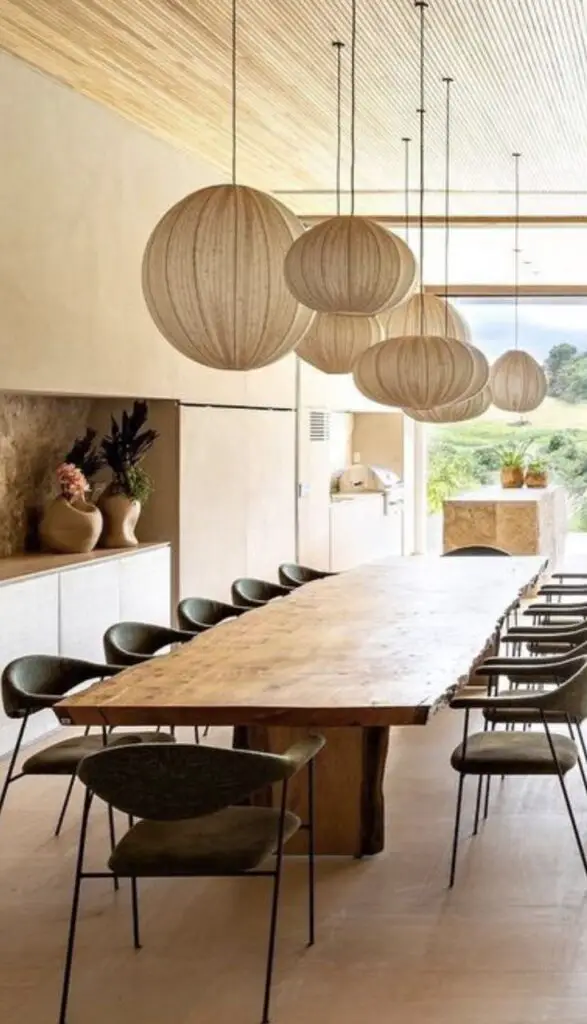
Paper globe shaped lighting
Merging the serene elegance of Japanese aesthetics with the cozy minimalism of Scandinavian design, these globe lanterns embody the essence of Japandi style.
Their sleek, geometric forms create a harmonious balance between simplicity and sophistication.
While the use of natural materials like pale wood and delicate paper pays homage to the organic elements central to this hybrid design philosophy.
These luminous orbs not only illuminate spaces but also serve as artistic focal points.
Infusing rooms with a zen-like ambiance that perfectly captures the fusion of two distinct yet complementary design traditions.
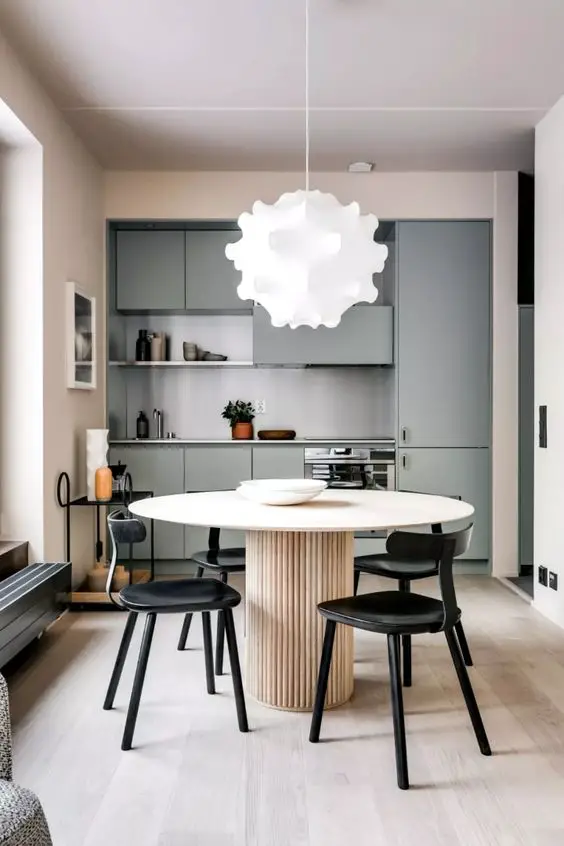
Dark accents
In Japandi dining spaces, the strategic use of dark accents elevates the aesthetic, marrying sophistication with contemporary flair.
Matte black chairs or deep charcoal tones create a captivating interplay against the style’s signature light woods and neutral hues.
This thoughtful contrast not only adds visual interest but also anchors the space, bringing depth and dimension to the serene Japandi ambiance.
By incorporating these darker elements, designers craft a dining environment that’s both harmoniously balanced and visually striking, embodying the essence of this fusion design philosophy.
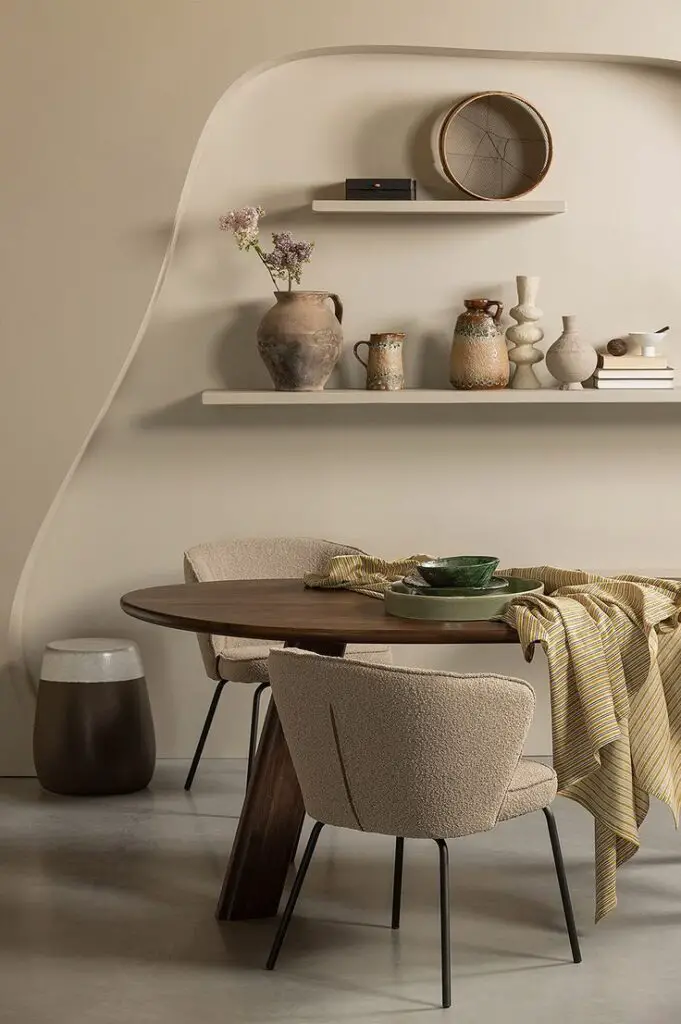
Organic shapes
Embrace the serenity of Japandi design in your dining space with the graceful allure of organic forms.
Imagine dining chairs with gentle curves that invite comfort, paired with a table adorned with handcrafted pottery of subtle, irregular shapes.
Framed by a wall with irregular shapes with floating shelves.
These elements work in concert to soften the room’s angles, fostering a sense of tranquility and balance that defines the essence of Japandi style.
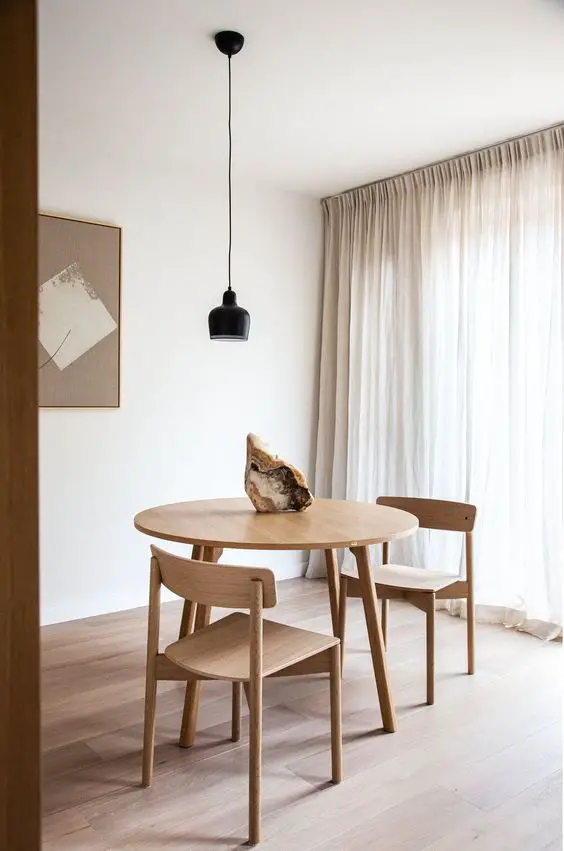
Flowy curtains
These window treatments, crafted from breathable fabrics like linen or cotton, offer more than just light control.
Their understated design softens harsh angles, transforming your space into a tranquil sanctuary.
With their effortless grace, these curtains don’t just frame your windows—they frame your entire aesthetic.
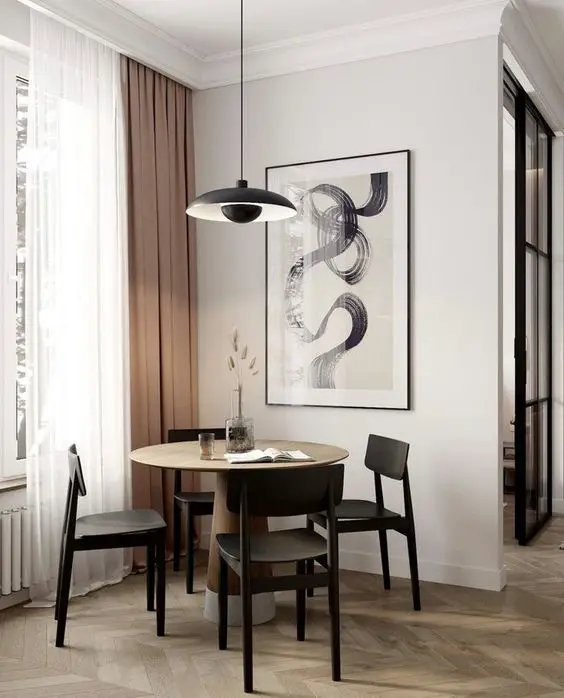
Statement artwork
A Japandi dining room often feature striking, oversized art pieces that command attention.
These carefully chosen works typically embody the aesthetic’s core principles: muted palettes, crisp contours, and organic forms.
Many pieces draw inspiration from nature, perfectly complementing the room’s minimalist ethos.
Such artwork serves as a focal point, elevating the space’s visual appeal while maintaining its serene ambiance.
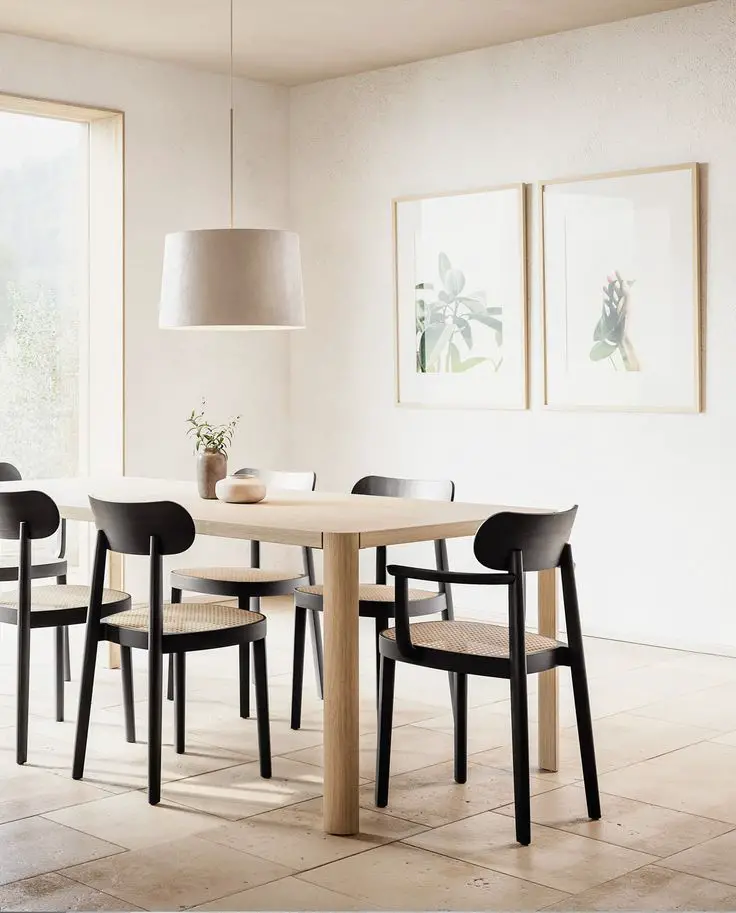
Curved black chairs
Breaking away from Japandi’s signature straight edges, these dining chairs bring a touch of softness to your meal times.
Their gracefully arched backs strike a perfect balance between minimalist design and cozy comfort, ensuring both style and support as you dine.
Don’t forget to Pin!

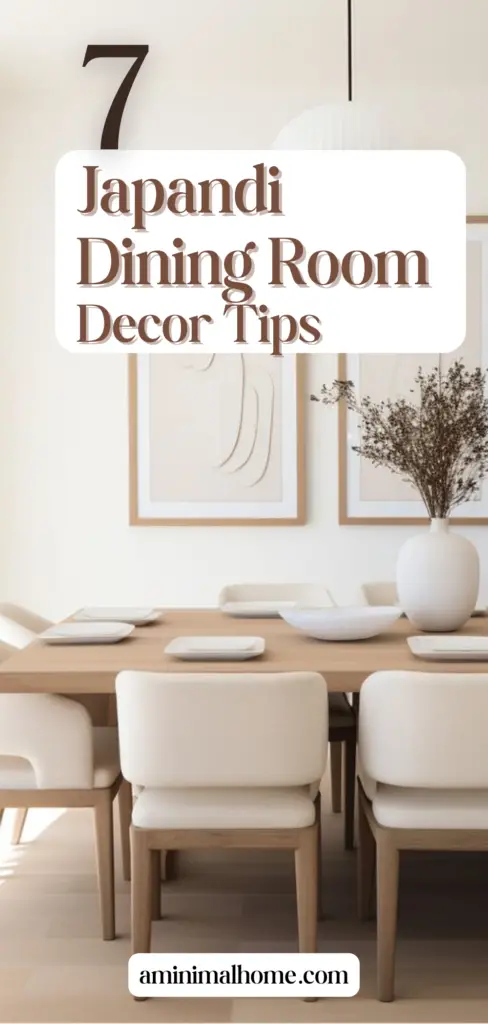
Conclusion
By embracing clean lines, natural textures, and a less-is-more philosophy, your dining area can become a stunning place.
Ready to embark on your Japandi journey? Stay with me and diascover more of this captivating design movement.



